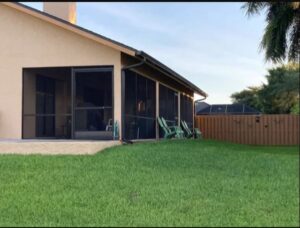
Screen rooms, also known as screened-in porches or sunrooms, have become a beloved feature in many homes, offering a versatile space that blends the comfort of indoor living with the beauty of the outdoors. These rooms are celebrated for their ability to provide protection from the elements while still allowing homeowners to enjoy fresh air and natural light. Over the years, the concept and design of screen rooms have evolved significantly, reflecting changes in architectural styles, technology, and lifestyle preferences.
The Origins of Screen Rooms
The idea of a screen room dates back to the late 19th and early 20th centuries, when homeowners began seeking ways to enjoy their gardens and outdoor spaces without being bothered by insects and inclement weather. Initially, these spaces were simple porches with mesh screens attached to the openings, allowing for ventilation and insect protection. As these screened porches gained popularity, they began to evolve in terms of design and functionality.
Architectural Advancements
As architectural styles progressed, so did the design of screen rooms. In the mid-20th century, there was a significant shift towards more sophisticated designs, incorporating elements such as aluminum framing and advanced screening materials that could withstand various weather conditions. These improvements made screen rooms more durable and aesthetically pleasing, aligning them with the architectural trends of the time.
In recent decades, screen rooms have become an integral part of modern home design. Contemporary screen rooms often feature floor-to-ceiling windows, retractable screens, and even glass panels that can be adjusted to provide varying levels of openness. This flexibility allows homeowners to enjoy their screen rooms year-round, regardless of the weather.
The Benefits of Screen Rooms
Connection with Nature: Screen rooms provide a seamless connection with the outdoors, allowing homeowners to enjoy the beauty of their surroundings without exposure to insects or harsh weather. This connection can have a positive impact on mental well-being, offering a peaceful retreat from the hustle and bustle of daily life.
Versatile Living Space: Screen rooms can serve a variety of purposes, from a casual dining area to a home office or a cozy reading nook. Their versatility makes them an attractive feature for homeowners who want to maximize their living space.
Increased Home Value: Adding a screen room can significantly increase a home’s value. Prospective buyers often appreciate the additional living space and the enhanced indoor-outdoor experience that a well-designed screen room provides.
Energy Efficiency: Screen rooms can also contribute to a home’s energy efficiency. By allowing natural light to flood the space, they can reduce the need for artificial lighting during the day. Moreover, the natural ventilation provided by screened openings can help regulate indoor temperatures, reducing the reliance on air conditioning.
Modern Innovations in Screen Room Design
Today’s screen rooms are a testament to innovation and creativity in home design. With advancements in materials and technology, these spaces have become more comfortable and adaptable than ever before.
Retractable Screens: One of the most significant advancements in screen room design is the development of retractable screens. These screens can be easily opened or closed, allowing homeowners to adjust the level of exposure to the outdoors. This feature is particularly beneficial in regions with fluctuating weather conditions, providing the option to enjoy the open air or close off the room for warmth and protection.
Climate Control: Modern screen rooms can be equipped with heating and cooling systems, ensuring comfort regardless of the season. This development has transformed screen rooms into year-round spaces, making them usable even in colder climates.
Smart Technology: The integration of smart technology has also revolutionized screen rooms. Homeowners can now control lighting, temperature, and even the positioning of screens through mobile apps or voice commands, enhancing convenience and personalization.
Sustainable Materials: As sustainability becomes a priority for many homeowners, screen rooms are increasingly being constructed with eco-friendly materials. Options such as reclaimed wood, recycled aluminum, and low-emission glass contribute to a more sustainable living environment.
Designing the Perfect Screen Room
Creating a screen room that meets both functional and aesthetic needs requires careful planning and consideration. Here are some key factors to keep in mind when designing your screen room:
Purpose and Layout: Determine how you intend to use the screen room. Will it be a dining area, a lounge, or a multi-functional space? This decision will influence the layout, furniture, and decor choices.
Orientation and Views: Consider the orientation of your screen room to maximize natural light and capture the best views. Positioning the room to face south or west can provide ample sunlight, while strategically placed windows can highlight beautiful outdoor landscapes.
Materials and Finishes: Select materials and finishes that complement the overall design of your home. Whether you prefer a rustic, natural look or a sleek, modern aesthetic, there are plenty of options to choose from.
Furnishings and Decor: Choose furnishings and decor that enhance the comfort and functionality of the space. Weather-resistant furniture, cozy textiles, and potted plants can create an inviting atmosphere.
The Future of Screen Rooms
As lifestyle trends continue to evolve, so too will the design and functionality of screen rooms. In the future, we can expect to see even more integration of smart technology, allowing for greater control over the environment and more personalized experiences. Additionally, the focus on sustainability will likely drive innovations in materials and construction techniques, leading to screen rooms that are not only beautiful and functional but also environmentally friendly.
In conclusion, screen rooms have come a long way from their humble beginnings as simple screened porches. Today, they are a testament to the blending of indoor and outdoor living, offering homeowners a versatile and valuable space that enhances their connection to nature. As they continue to evolve, screen rooms will undoubtedly remain a cherished feature in homes, providing a sanctuary for relaxation, entertainment, and enjoyment of the natural world.

